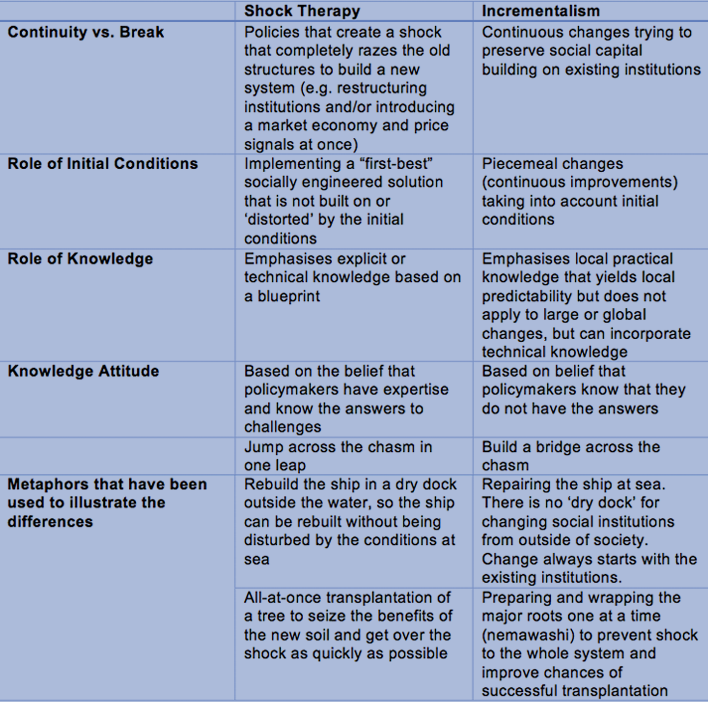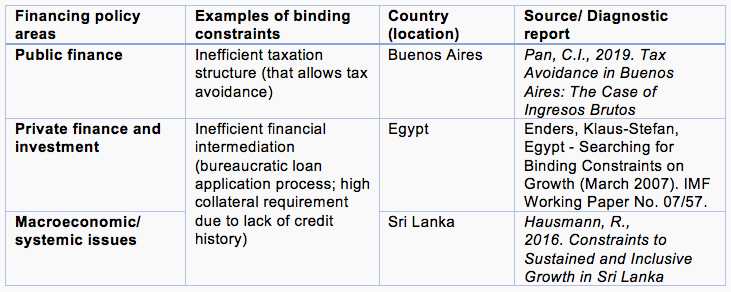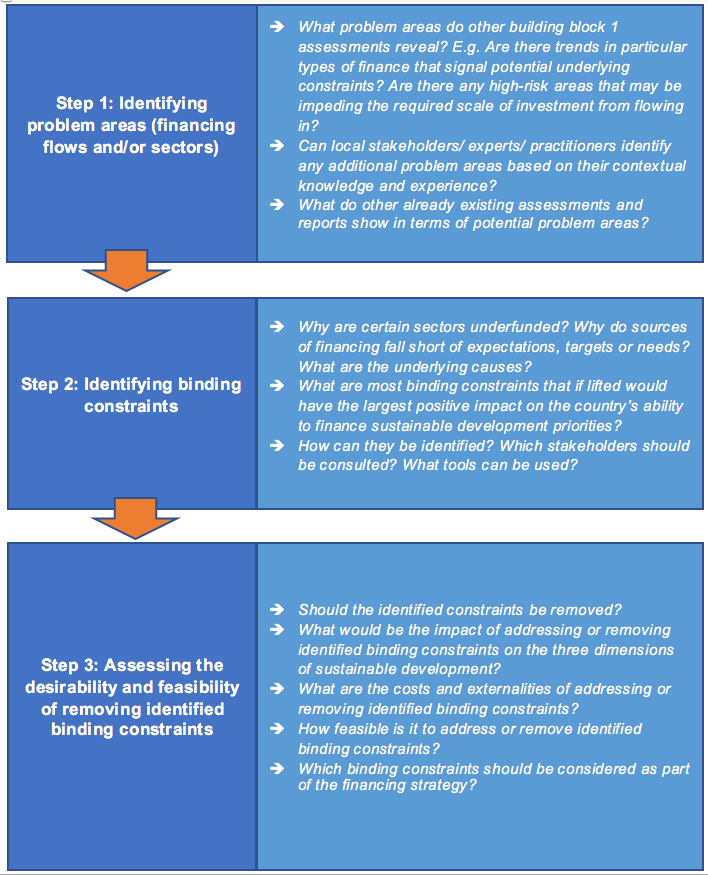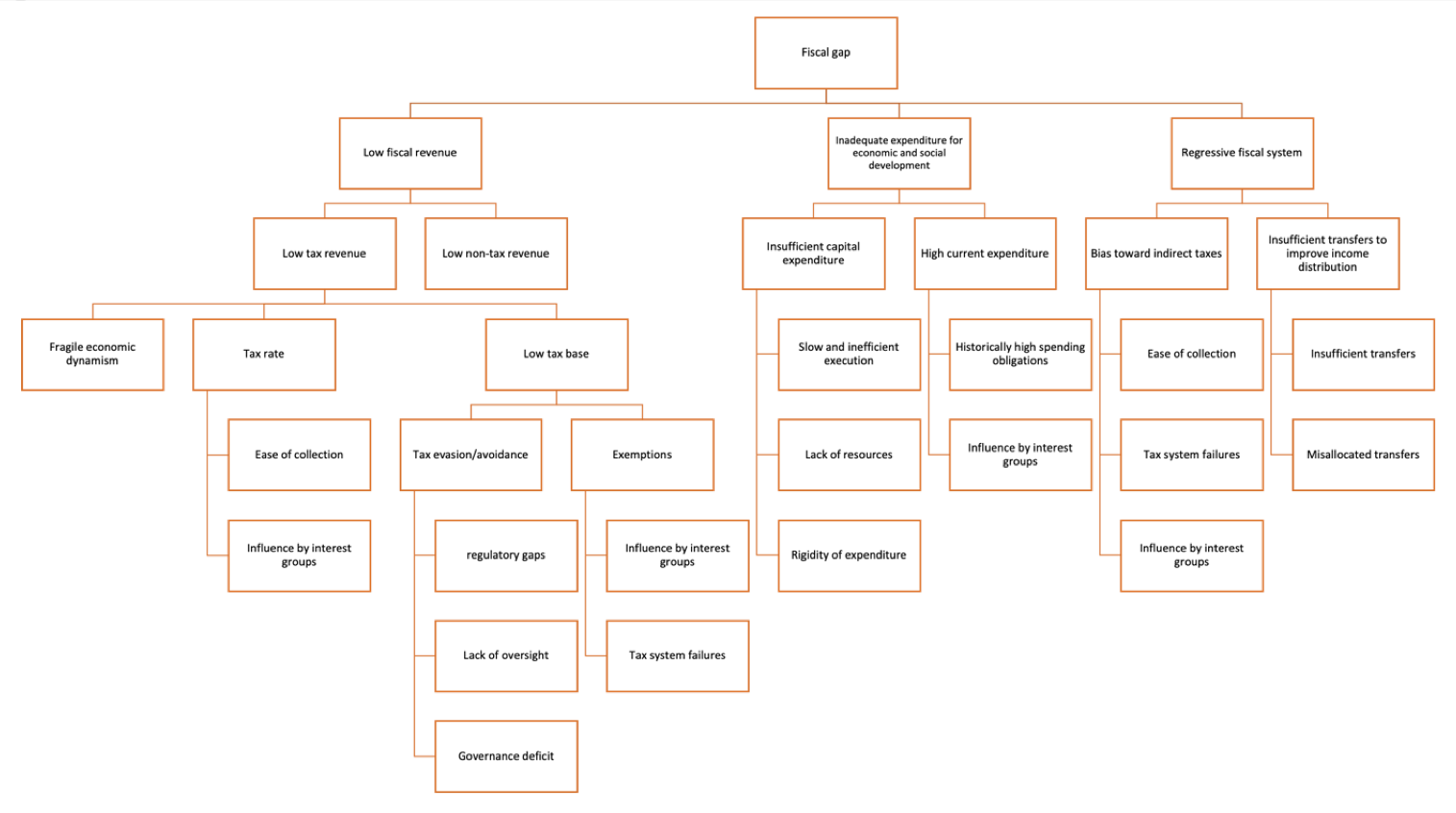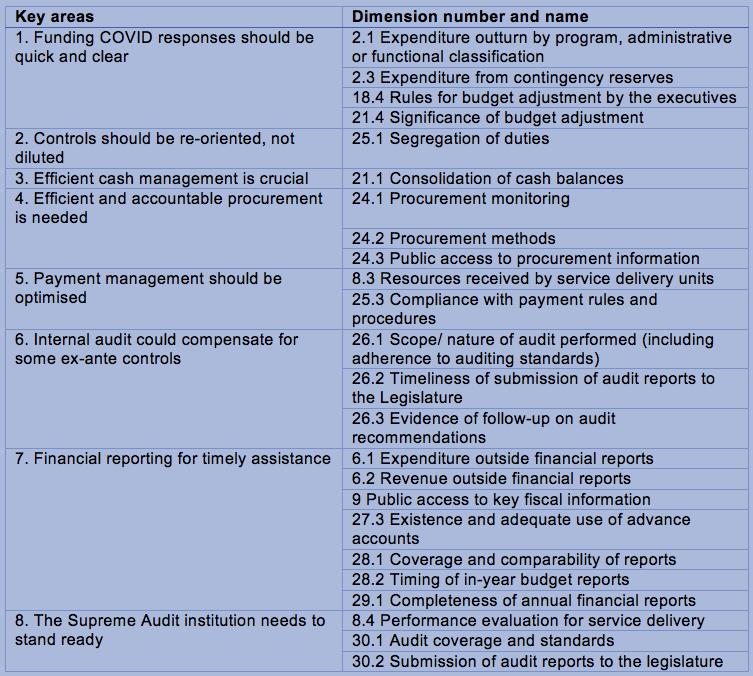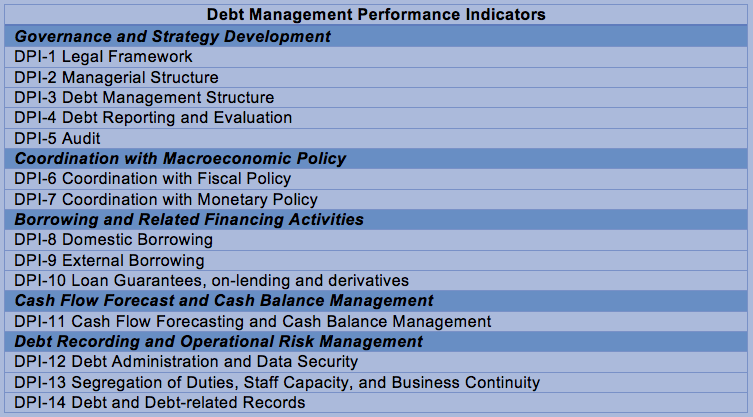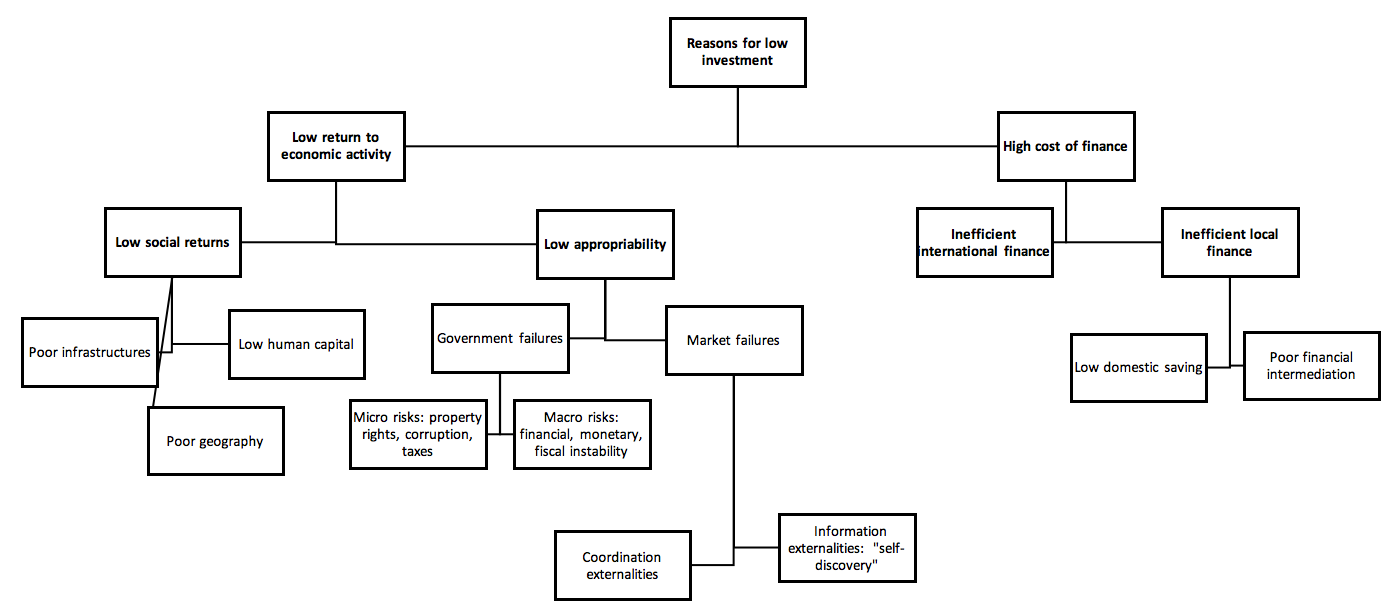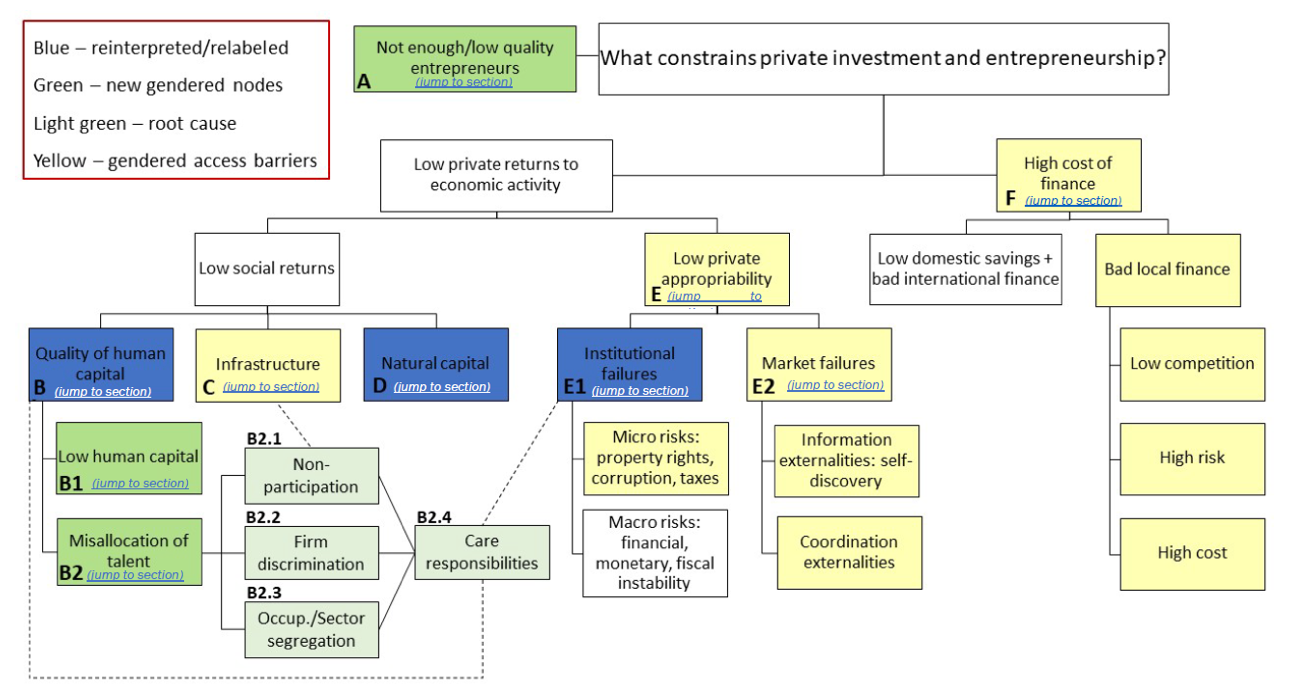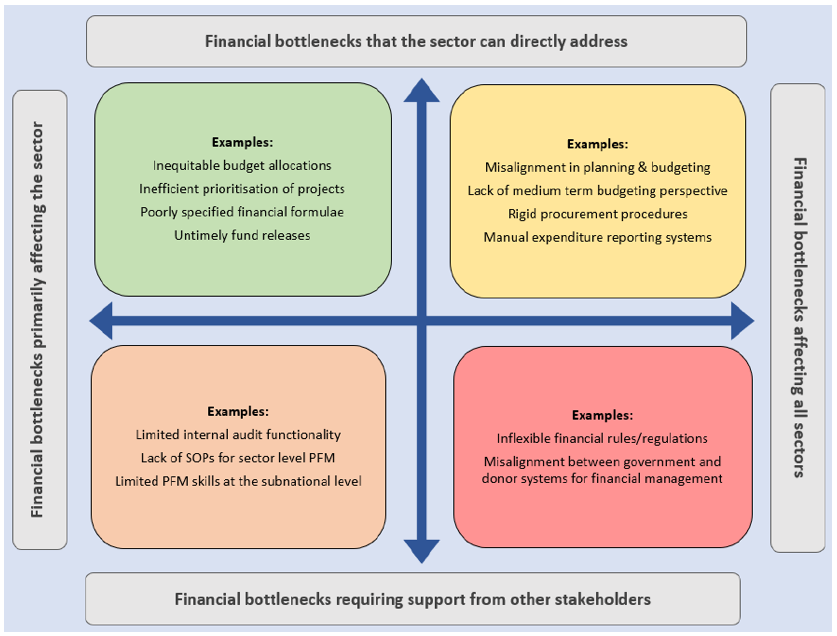Once problem areas have been identified, the
second step is to ask a series of why questions (e.g. why is
government spending in the education sector below needs? Why are tax revenue
levels low compared to set targets? Why is foreign investment poorly aligned
with national sustainable development priorities? Why do women-owned MSMEs have
lower-than-average access to finance?) and determine the major underlying
causes, or in other words, the most binding constraints.
A structured series of dialogues and inquiry, following steps a) through
e) laid out below, assesses each of the problem areas identified in Step 1 by asking
questions, and gathering relevant evidence and perspectives from stakeholders
to facilitate the identification of related binding constraints (Sections 4.2.1
and 4.2.2 provide examples of its application in both public and private
finance problem areas). The problem areas identified in Step 1 will determine the
experts and practitioners that should be consulted, as well as the most
suitable tools and sources of data and evidence. For example, if problem areas
are identified in particular sectors (e.g. health/ education/ agriculture/
housing/ etc.), relevant sector-specific expertise and knowledge will have to
be sought. Section 4.4 lists tools and assessments available from the international
community that countries can draw upon to complement local knowledge and expertise;
they range from public financial management and investment assessment tools to
private sector diagnostics, productive capacity and financial sector
assessments.
a) Turn the problem area into a
‘why’ question to guide the exercise. For example,
why is tax revenue below target levels? Why is domestic private investment
lower than in peer economies? The set of plausible answers become the branches
of a ‘decision-tree’ to further explore.
b) Explore and map possible
answers to the ‘why’ question. By drawing on local
knowledge and evidence from existing assessments (such as those listed in Section
4.4), possible reasons that may explain the problem area can be mapped, all the
way down to the fundamental underlying causes, or in other words, the possible binding
constraints. All possible types of
binding constraints should be considered, including market-related,
institutional, policy and/or capacity-related constraints. It is critical at
this stage to involve the right stakeholders (relevant government and non-state
actors who can provide concrete insight from the implementation level) so that
no potential binding constraint is left out of the short-list, including ones
that may be particularly relevant to specific segments of the population.
c) Formulate a binding
constraint hypothesis. One of the short-listed
binding constraints is posited as a primary underlying cause of the problem.
d) Test the hypothesis. The identification of binding constraints is often a matter of
judgement and not precise science, and thus relies on insights from local
experts and specialists. Nonetheless, constraints that are truly binding should
exhibit certain properties that
can guide hypothesis testing. Quantitative analysis, where appropriate, and
consultations with practitioners and institutional stakeholders can shed light
on whether certain constraints are indeed binding in the specific
national context:
i. Would increased supply of a constrained
input have a large impact on the ‘objective function’, e.g. the price or cost
of the objective? The constraint has a high
price/ “shadow price”. While “shadow prices” are not always observable, they can be signalled by
market prices. For example, high real interest rates can signal that access to
finance is scarce and potentially a binding constraint.
ii. Would removal of the
constraint provoke a major positive impact in the problem area? Changes in the constraint would produce shifts in costs, incentives
and behaviour. For example, service delivery providers in the public sector
(e.g. in health or education) may be able to pinpoint those aspects of public
financial management that most adversely affect them. If access to finance is the
most binding constraint to domestic private investment, increased availability
of credit would significantly increase investment.
iii. Do agents affected by the
problem attempt to bypass or overcome the constraint? There is inefficient or costly economic behaviour in the problem
areas. Agents often find alternatives to circumvent constraints, such as barter
during hyperinflation or borrowing at high interest rates in the informal
sector due to banks’ high collateral requirements.
iv. Do individuals, firms and
institutions less reliant on the constraint perform better than others? Those not as impacted by the constraint are more likely to survive
and thrive, and vice-versa. For example, in the case of access to finance being
posited as a binding constraint to domestic private investment, firms in
sectors that are more likely to be able to self-finance investments will be
performing better than those that depend on debt and external financing.
e) Repeat c) and d) until the
right binding constraint is identified. If the
binding constraint posited in step c) is found not to meet properties listed in
step d), an alternative hypothesis is formulated and tested until the right binding
constraint related to the specific problem area is identified.
The approach is inspired by the
‘growth diagnostic’ methodology, which at its core seeks to identify a
small set of key obstacles to economic growth relevant to the specific national
context (instead of following international ‘best practice’ or ‘cookie-cutter’
approaches), and to strategically focus efforts and limited capacities and
resources (or ‘political capital’) for policy change and reform. INFFs are
broader in ambition. All dimensions of sustainable development come into play,
and constraints beyond those that may be unearthed using a growth diagnostic
are also relevant (e.g. public financial management and state capacity issues).
As such, the approach outlined here borrows the problem-driven, decision-tree
method of growth diagnostics but applies it to the broader objective of INFFs.
4.2.1. Applying the approach to public finance
An illustration of how the approach may be
applied to a public finance related problem area is provided in Figure 2. In
2016, the government of Costa Rica, with technical support from the UN Economic
Commission for Latin America and the Caribbean (ECLAC), assessed the structural
economic, social and institutional gaps of Costa Rica. The report
drew attention to institutional and capacity gaps in the tax system that
explained its ‘fiscal gap’, or, in other words, the structural challenges in
its fiscal system to manage resource mobilization and public spending to
support sustainable and inclusive development. A decision tree was developed to
assess binding constraints, mapping three potential drivers of the fiscal gap:
low fiscal revenue, inadequate expenditure for social and economic development,
and a regressive fiscal system. The analysis concluded that low tax revenue was
the main reason behind Costa Rica’s fiscal gap, and that the most binding
constraint underlying such low levels of tax revenue were low income and sales
tax revenues, as a result in part of high levels of tax avoidance and evasion
(see Figure 2).
